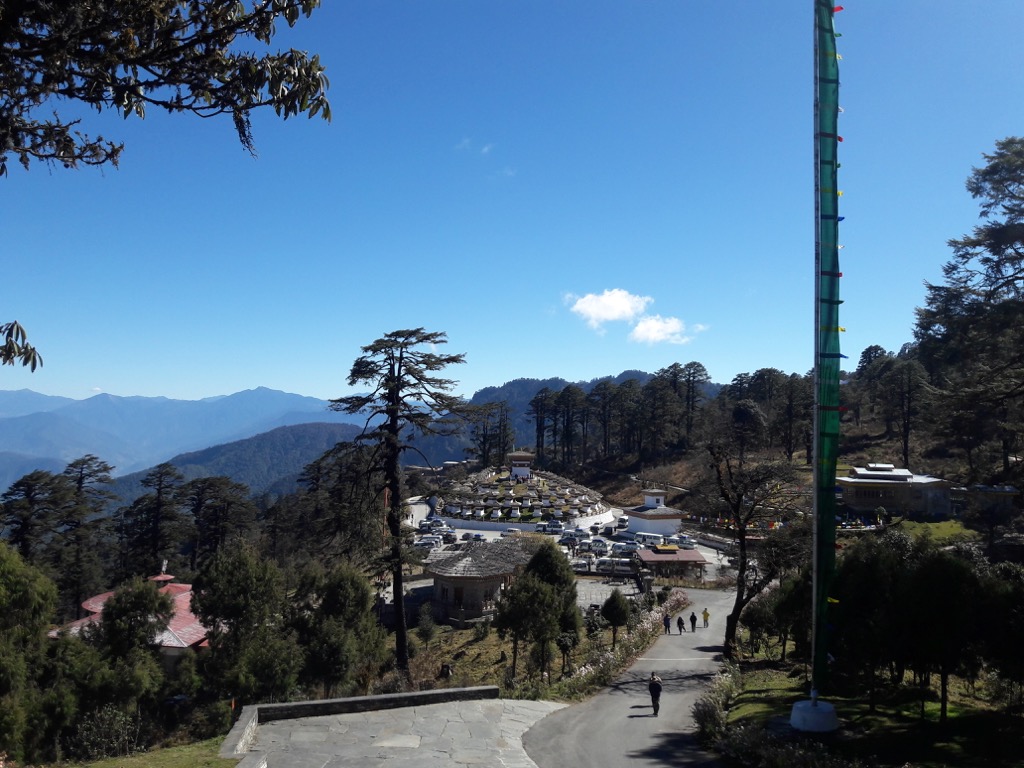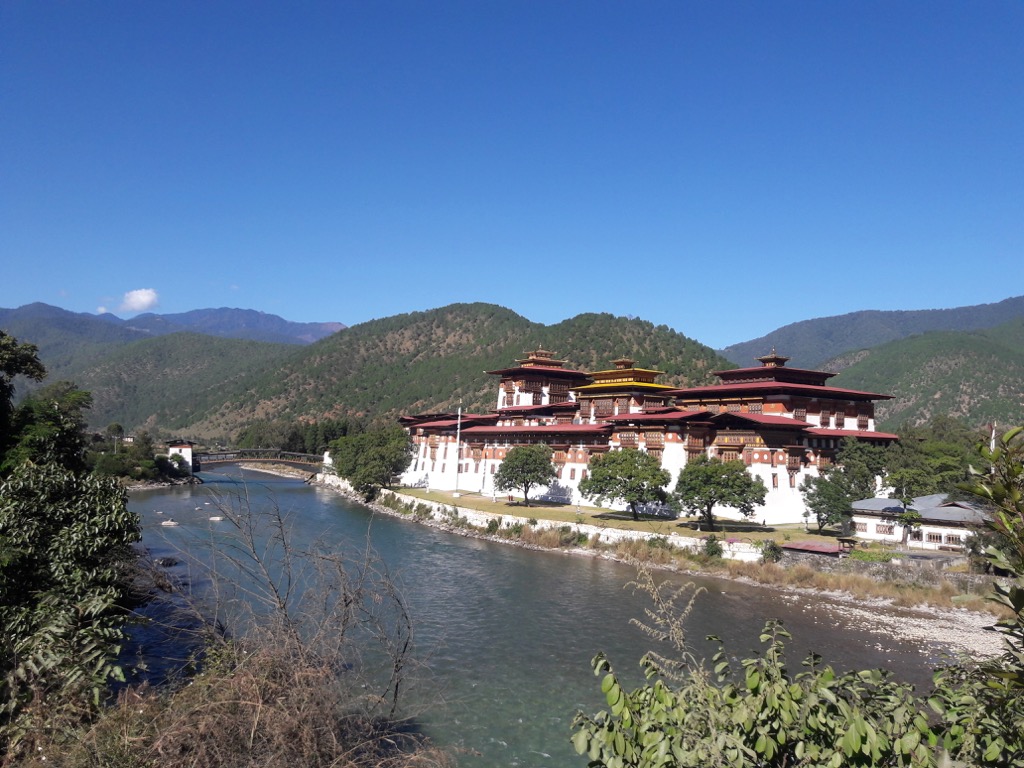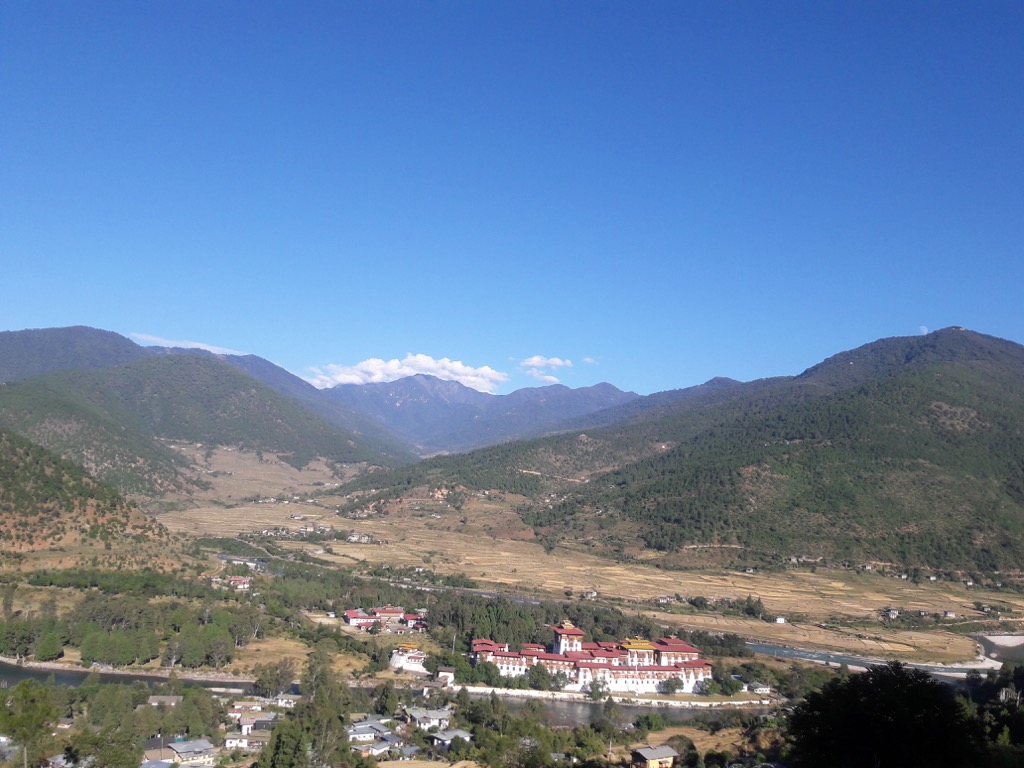Gomphu Kora Festival
|
|
Gomphu Kora is situated 23 kilometres from Trashigang Dzong, the headquarters of Bhutan’s most populous district.
Gomphu means “Meditation Cave” and Kora means “Circumambulation”. The name is derived from a cave formed out of a rock-face next to a temple that has been built as a tribute to this sacred site.
The story of Gomphu Kora goes back to the 8th century AD. Legend has it that an evil spirit named Myongkhapa escaped from Samye in Tibet when Guru Padmasambhava was spreading the Dharma in the Himalayas. Myongkhapa followed the course of the present-day Kholongchhu stream and concealed himself inside a rock where Gomphu Kora stands today. The Guru followed the evil, mediated for three days inside the rock cave and finally vanquished it.

Several prominent religious personalities have undertaken pilgrimage to Gomphu Kora and the earliest was Gongkhar Gyal, grandson of Lhasay Tsangma. He built a small shrine at Gomphu Kora around the 10th century A.D. In the 14th century, Terton Pema Lingpa, visited Gomphu Kora and enlarged the existing shrine. It was renovated and enlarged in the 15th century by Yongzin Ngagi Wangchuk, the grandfather of Zhabdrung Ngawang Namgyel (who unified Bhutan). He also inscribed murals on the walls of the temple.
The biggest attraction of Gomphu Kora is the circumambulation. “Go around Gomphu Kora today for tomorrow may be too late”, advises a local song that entices devotees to visit Gomphu Kora. The place comes alive, once every year in early spring (from March 27 to 29, 2015) when people all over eastern Bhutan descend upon the narrow valley, dressed in their finery, to partake in the festivity, to worship and to reaffirm their connection with the past.
The sanctity of the three day religious festival even draws devotees from neighboring areas as far as Arunachael Pradesh (India).
11 Night 12 Day Gomphu Kora Festival Tour Packages
Day 1 Arrive Paro
If you arrive on a bright sunny day, your holiday began with the panoramic view of the Himalaya range from your flight seat, you will be greeted by Mt. Everest and Mt. Kanchenjunga, and our very own Mt.Jomolhari and Mt.Jichu Drakey. An unparalleled feeling while you are descending over Bhutan is a feeling which is of total abandonment, a feeling which is inexplicably, compassionate and full of suspense as visibly seen in the growing communion between the passengers.
Upon arrival you will be received by our guide who will help you settle into your comfortable car.
Check into the hotel. After the lunch visit the following places.
RinpungDzong
Built in 1646 by Shabdrung Ngawang Namgyal , the first spiritual and temporal ruler of Bhutan, the Dzong houses the monastic body of Paro, the office of the Dzongda (district administrative head) and Thrimpon (judge) of Paro district. The approach to the Dzong is through a traditional covered bridge called Nemi Zam. A walk through the bridge, over a stone inlaid path, offers a good view of the architectural wonder of the Dzong as well as life around it. It is also the venue of Paro Tshechu, held once a year in the spring.
Then you will visit one of the clusters of farm houses in Paro Valley and a visit to a farm house offers a good glimpse into the lifestyle of a farmer.
Ta Dzong
One time watch tower built to defend Rinpung Dozng during inter-valley wars of the 17th century, since 1967 Ta Dzong is serving as the National Museum of the country. It holds fascinating collection of art, relics, religious thangkha paintings and Bhutan’s exquisite postage stamps. The museum circular shape augments its varied collection displayed over several floors
Dinner & overnight at a hotel in Paro.
Day 2 Hike to Tiger’s Nest
After breakfast travel by car to the base camp of Tiger’s Nest Monastery and then hike up to Taktshang Monastery, also known as ‘Tiger’s Nest’. The climb up to the viewpoint will take around 1 ½ hours and from there you will enjoy a spectacular view of the monastery clinging to the side of the cliff. Stop for refreshment at the View Point Cafeteria.Then walk further up to the monastery which will take another 1 ½ hour. It is said that in the 8th century Guru Rinpoche flew on the back of a tigress from eastern Bhutan to this place and meditated in a cave here for 3 months. The principal Lhakhang (monastery) of the present monastic complex dates from 1692. Taktshang was damaged severely by fire in 1998 but has now been fully restored to its former glory.After visiting the monastery, walk back down to the road on the way stop for lunch at the view point cafeteria and then walk further down to the road point.
On the way visit Kyichu temple,one of the 108 temples built in the 7th century by the Tibetan King Songsten Gampo. The story goes that a giant demon lay across the whole area of Tibet and the Himalayas and was preventing the spread of Buddhism. To overcome her, King Songtsen Gampo decided to build 108 temples, which would be placed on all the points of her body.
Dinner and overnight at a hotel in Paro.
Day 2 Paro-Thimphu (54 km-1 hour drive)
After your breakfast,you will be driving toward Thimphu.
Bhutan Post Office Headquarters to get personalized Bhutanese postage stamps with your photo on them. You can bring along your favorite photo to put on the stamps and put these stamps on your postcard to send to your family and friends.
National Textile Museum which is a good place to see the art of traditional weaving being kept alive and preserved through exhibition and has a good collection of old textiles which are rich in colors and designs. You will also see people weaving with intricate designs.
Traditional Bhutanese paper making factory. The handmade paper making in Bhutan stemmed from the age old tradition originated in 8th century of Bhutanese history. The handmade paper constitutes as valuable National heritage of Bhutanese cultural identity and is preserved through all the ages. The Traditional paper is recognized and held high esteem both in home and outside world. Jungshi Paper Factory was established in November 1990 as an undertaking of the Royal Government of Bhutan. The unit now boasts as a major and sole dealer in handmade paper and its products.

After lunch visit the following:
National Institute of Traditional Medicine(outside only), where medicinal herbs are compounded and dispensed, and traditional medical practitioners trained.
The School of Traditional Painting of Arts and Crafts where students undertake a six-year course on the 13 traditional arts and crafts of Bhutan.
Takin Preserve which houses the national animal the Takin that is only found in Bhutan. This is an extremely rare member of the goat family. Found in herds in the very high altitudes (13,125ft and over). They live on a diet of grass and bamboo. It can weigh as much as 550 pounds.
Tashichhoe Dzong, a fortress of the glorious religion. It was built in 1641 by Zhabdrung Ngawang Namgyel and was reconstructed into present structure by the late King, His majesty Jigme Dorji Wangchuck in the year 1962-1969. It houses the secretariat building, the throne room and the office of the king, and the central monk body.
Dinner and overnight at a hotel in Thimphu.
Day 4 Thimphu-Punakha (77 km-3 hours drive)
After early breakfast, you will drive towards Punakha via Dochula Pass.
Dochula pass is located on the way to Punakha from Thimphu. The pass is popular for tourists for its ideal location from where one can enjoy 360 degree of beautiful panoramic view of Himalaya mountain range, especially on clear winter days. The beauty of this place is further enhanced by the Druk Wangyal Chortens-108 stupa built by the eldest Queen Mother Her Majesty Ashi Dorji Wangmo Wangchuk. The pass is also popular spiritual place for both locals and tourists because of an important temple that is located on the crest of Dochula pass.
Her Majesty Ashi Dorji Wangmo Wangchuck has achieved a fine blend of history and mythology in the construction of The Druk Wangyal Lhakhang (temple) to honor His Majesty the fourth Druk Gyalpo, Jigme Singye Wangchuck. The past and future appear to merge in the details of the lhakhang (temple) that tells the story of a supreme warrior figure whose vision pierces the distant future.
Besides the spirituality of the place many Bhutanese families visit the pass during holidays and weekends to simply enjoy the scenery of the place with their pack lunch and hot tea. For the tourist the place is an ideal location to capture beautiful pictures of Himalaya mountain range during clear warm days.
Punakha Dzong
Placed strategically at the junction of the Pho Chu and Mo Chu rivers, the dzong was built in 1637 by Zhabdrung Ngawang Namgyal to serve as the religious and administrative seat of the region. It was here that the dual system of government was introduced in the 17th century and in 1907, enthroned the first King Gongsar Ugyen Wangchuck. Damaged over the centuries by four catastrophic fires and an earthquake, the dzong has been fully restored in the recent years by the 4th King Jigme Singye Wangchuck. At the dzong enrich your trip with the opportunity to see the highest standards in woodwork. Do not miss the massive Kuenray, the Coronation Hall of all Bhutanese kings, the Dzongchung at the entrance to the dzong and the cantilever bridge over the Mochu that has been recently renovated.
Chimi Lhakhang
The Chimi Lhakhang, situated on a hillock in the centre of the valley, is dedicated to Lama Drukpa Kuenley, who in the late 15th century used humour, songs and outrageous behavior to dramatise his teachings and due to this also known as “Divine Madman”. This temple is also known as the temple of fertility. It is widely believed that couples who do not have children and wanting one, if they pray at this temple, they are usually blessed with a child very soon. It is about 30 minute walk across field from the road to the temple. The trail leads across rice fields to the tiny settlement of Pana, meaning “field”. It then follows a tiny stream downhill to Yoaka and across more fields before making a short climb to Chimi Lhakhang.
Overnight in a hotel in Punakha.
Day 5 Punakha-Trongsa(130 km-5 hours drive)
After breakfast, travel to Trongsa through Wangdue Phondrang with lunch served enroute. Trongsa is the ancestral home of the royal family. The drive will take you through dense forests of oak trees and rhododendrons and through the tropical vegetation through the village of Nobding and Pele la pass (11,000ft). Throughout your trip you will come across the beautiful sceneries of rural Bhutan, with scattered settlements far from the road which makes for good photographing.You will also pass through open meadows, and valley of yak herders and several other villages via Chendebji Chorten (Stupa). On arrival at Trongsa and after the refreshment visit the Trongsa National Museum which is housed in the Ta Dzong (watch tower). A museum in which aspects of Bhutanese culture and history are explained by beautifully objects. Documentary will be shown too which explains a great deal about Bhutanese history and history of monarchy.
You will also visit Trongsa Dzong,built in 1648 it is an architectural masterpiece and it is the most impressive dzong in Bhutan.
In the evening visit Trongsa downtown. Dinner and overnight at a hotel in Trongsa.

Day 6 Trongsa-Bumthang(68 km-3 hours drive)
After breakfast, drive to Bumthang, this is one of the most spectacular valleys in Bhutan and also the heartland of Buddhism. Here the great teachers meditated and left in their wake many sacred grounds. The Guru Rinpoche and his lineage of Tertons, treasure finders, have led to the sprouting of many temples in the valley. On the way, visit the “Yathra” weaving centre at Zugney and spend some time interacting with the local weavers. Yathra is the name for the colorful, hand-woven woolen cloth (often with geometric designs) that is produced in this region and wool used for this type of textile is sheep wool as the sheep is reared in this Bumthang district.Yatra is made into jackets or bags ,etc. Then drive onto Bumthang and Check into hotel.
After lunch, Bumthang sightseeing includes visit to the following:
Jampa Lhakhang, built in the 7th century by the King Songtsen Goempo of Tibet. In his effort to propagate Buddhism, he had a plan to build a total of 108 temples in Tibet and neighboring kingdoms.
Kujey Lhakhang(Kujey means, “Body imprint”). The temple to the right is the oldest and was built by Minjur Tempa in 1652. It was built around the cave in which Guru Rimpoche meditated and left his body imprint.
Jakar Dzong, “castle of the white bird”. According to legend, when the lamas assembled in about 1549 to select a site for a monastery, a big white bird rose suddenly in the air and settled on a spur of a hill. This was interpreted as an important omen, and the hill was chosen as the site for a monastery and for Jakar Dzong. The fortress is now used as an administrative center of Bumthang district and summer residence of Trongsa monks.
In the evening stroll around the beautiful landscape of the Bumthang valley.
Dinner and overnight at a hotel in Bumthang.
Day 7 Bumthang-Mongar (198 km-7 hours drive)
After breakfast, continue your journey eastwards to Eastern Bhutan , winding through more rugged terrain. The drive, with spectacular views, will take about 7 hours. Pass through Ura Valley in Bumthang before climbing sharply to the highest motor road pass in the Kingdom, the Thrumshingla Pass 12,465 ft. Gradually drop down to Sengor where you will stop for lunch. You will come across cascading waterfalls along the way. The descent stops at 2,130 ft on a bridge over the Kurichu. Climb again through pine forest, maize fileds and eastern hamlets to Mongar town. On arrival at Mongar check into your hotel and in the evening stroll around Mongar town.
Dinner and overnight at hotel in Mongar.
Day 8 Mongar-Trashigang (91 km-3 hours drive)
After breakfast,drive to Trashigang. The road from Mongar to Trashigang, the eastern most region, begins through lush forests and ferns passing over the Kori La at 8,000 ft. After driving about an hour, you reach the village of Ngatshang, the site of one of the fiefdoms before unification of the nation. Descending rapidly through corn fields and banana groves, you reach Yadi village. Follow the Gamri river until the bifurcation to Drametsi. This temple, perched atop a steep hill, was founded by Nun Choden Zangmo in the 16th century. This is the place from where the famous Drametsi Nga Chham, mask dance with drums, originated. About 30 kilometres onwards lies Trashigang, at 3,775 ft. Trashigang is the center of the biggest and most populated district in the nation. View the dzong, built strategically on a spur going out towards the Gamri Chu.
After lunch, visit Khaling, it is the weaving center under women association of Bhutan,Government of Bhutan. There you can see all the process and materials involved in weaving. Drive back to Trashigang for overnight stay.
Day 9 Gomphu Kora Festival
After breakfast, travel for about 23 kms to Gomphu Kora with packed picnic lunch and enjoy the festival and free interaction with local people.People from all over eastern Bhutan and neighboring Indian state of Anurachal Pradesh, dressed in their finest cloths gather at the Gomphu Kora festival and take part in the festivities
After the festival, return to Tashigang. Dinner and overnight at a hotel in Trashigang.
Day 10 A day trip to Tashiyangtse
Trashigang-Trashiyantse 54 km x 2
After breakfast,drive to Tashiyangtse. The people here are known for making wooden bowls and containers, which are said to be the best quality found in Bhutan. Visit the Arts School and the Chorten Kora. On the way to Tashiyangtse you will stop at the Gom Kora temple, behind which is a large black rock. It is said that Guru Rimpoche meditated in a cave in which you can see the impression of his thumb, his hat, and his body on the rock. Then visit the abandoned iron chain link bridge behind the village of Duksum. It is said that this is the last remaining bridge of those built by a Tibetan bridge builder by the name of Thangthong Gyalpo in the 15th century.
Return to Trashigang for overnight stay. Dinner and overnight at a hotel in Trashigang.
Day 11 Trashigang-Samdrupjongkhar (180km-9 hours drive)
After breakfast drive to Samdrupjongkhar with lunch enroute. On the way visit Khaling, it is the weaving center under women association of Bhutan,Government of Bhutan. There you can see all the process and materials involved in weaving.
Overnight at Samdrupjongkhar.
Day 12 Depart from Samdrup Jongkhar
In the morning, your tour guide will see you off at SamdrupJongkhar from where you will travel to Guwahati Airport for your onward journey.